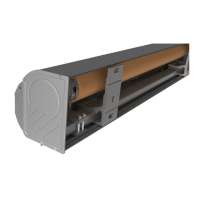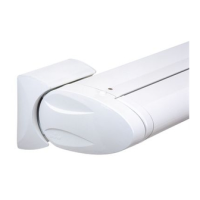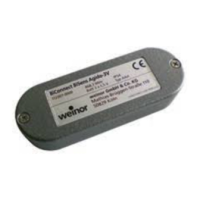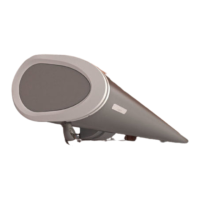Wichtige Information
Important Information
㛯㛯㛯
Nutzung bei Regen
Ist die Neigung der Markise geringer als 25% = 14°
gemessen von der Waagerechten, so darf diese im
Regen nicht ausgefahren werden. Es besteht die Gefahr
einer Wassersackbildung im Markisentuch, durch den
die Markise beschädigt werden oder abstürzen kann.
㛯㛯㛯
Nutzung bei Schnee und Eis
Die Markise darf bei Schneefall oder Frostgefahr nicht
ausgefahren werden. Es besteht die Gefahr, dass die
Markise beschädigt wird.
Eine Automatiksteuerung muss unbedingt bei Frostgefahr ausge-
schaltet werden.
㛯㛯㛯
weinor Produkte werden mit großer Sorgfalt hergestellt;
dennoch sind und bleiben Ihre weinor Produkte Sonnen-
schutzanlagen.
Eine nass eingefahrene Markise sollte nach dem Regen – zum
Trocknen des Tuches – wieder ausgefahren werden.
Die Markise kann bis zum maximalen Ausfall in jede Zwischen-
position gefahren werden.
Die Hochschlagsicherung bei Kippgelenkarm-Markisen wird im
1. Drittel des Ausfahrvorganges aktiv.
Unsere Empfehlung: Fahren Sie Ihre Markise ganz aus, so erreichen
Sie in den meisten Fällen den besten Sonnenschutz.
Ist Ihre Markise mit Motor ausgerüstet, dann beachten Sie bitte:
Der Motor hat – bauartbedingt – eine Einschaltdauer von maximal
vier Minuten. Wird die Einschaltdauer – z.B. durch häufiges Ein-
und Ausfahren – überschritten, kann der interne Thermoschutz
den Motor automatisch abstellen.
Bitte warten Sie in diesem Fall, bis sich der Motor abgekühlt hat
(je nach Außentemperatur ca. 15–20 Minuten) und wieder
betriebsbereit ist.
㛯㛯㛯
Hindernisse
Im Ausfahrbereich der Markise dürfen sich keine Hinder-
nisse befinden. Es besteht die Gefahr, dass Personen dort
eingequetscht werden.
㛯㛯㛯
Automatiksteuerung
Wichtiger Sicherheitshinweis:
Eine Markise darf niemals unbeaufsichtigt ausgefahren
sein. Eine Automatiksteuerung kann unter extremen
Bedingungen versagen (z.B. Stromausfall, Defekte, plötz-
lich auftretende Unwetter). Es besteht die Gefahr, dass
die Markise beschädigt wird oder abstürzt.
Empfehlung: Bei Abwesenheit die Automatiksteuerung auf manu-
ellen Betrieb stellen und die Markise eingefahren lassen.
㛯㛯㛯
Bedienung bei Stromausfall
Eine motorgetriebene Markise lässt sich ohne Strom nicht
einfahren. Erwägen Sie in windreichen Gegenden mit
häufigen Stromausfällen den Einsatz einer manuellen
Nothandbedieneinrichtung (nicht bei allen Modellen
erhältlich). Das Bedienteil der Nothandbedienung muss in
einer Höhe von weniger als 1,8 Meter zugänglich sein.
Bei Frostgefahr müssen Sie die Automatik auf manuellen
Betrieb umstellen, um ein automatisches Fahren der
Anlage zu unterbinden.
Bei Frost oder Frostgefahr darf die Anlage nicht in Betrieb
genommen werden.
6
Gelenkarmmarkisen
Use in the rain
If the awning’s angle of pitch is less than 25% = 14°,
measured from the horizontal, it must not be opened in
the rain. There is a risk of puddles forming in the awning
fabric which could damage the awning or cause it to fall.
㛯㛯㛯
Use in snow and icy conditions
The awning must not be opened during snowfall or if
there is a risk of frost. There is a risk of damage to the
awning or it falling.
It is essential that any automatic control is switched off if there is a
danger of frost.
㛯㛯㛯
weinor products are made with the greatest of care.
Nevertheless, your weinor products are and will remain
sun protection systems.
An awning which is wet when retracted should be extended again
once the rain has stopped so that the cover may dry.
The awning can be extended up to its maximum length in any
interim position.
The drop arm lock on pivoted joint arm awnings becomes active in
the 1st third of the extension process.
We recommend: Allow your awning to extend as far as it will go
as this will provide you with the best possible sun protection in the
majority of cases.
If the awning is equipped with a motor, please observe the follow-
ing: Due to the design, the motor has a maximum power-on time
of four minutes. If the power-on time is exceeded – e.g. due to
frequent retracting and extending of the blinds – the internal ther-
mal protector may well cause the motor to turn off automatically.
In this instance, please wait until the motor has cooled down
(depending on the outside temperature, this may take approx.
15–20 minutes) and is ready for operation once again.
㛯㛯㛯
Obstacles
There must not be any obstacles in the area of the
awning’s movement. There is a danger of persons being
squashed there.
㛯㛯㛯
Automatic control
Important safety note:
An awning must never be opened without supervision.
Automatic controls may fail under extreme conditions
(e.g. power failure, faults, sudden storm). There is a risk
of damage to the awning or it falling.
Recommendation: When away, switch the automatic control to
manual and retract the awning.
㛯㛯㛯
Operation in the event of a power failure
A motorised awning cannot be retracted without power.
In windy areas subject to frequent power failures the
use of an emergency manual operation facility or an emer-
gency power supply should be considered (not for all mod-
els available). The emergency manual operation controls
must be accessible at a height of not more than 1.8 metres.
If there is a danger of frost, always ensure that you switch
from automatic to manual operation so as to prevent the
system from working automatically.
Never operate the system in frosty conditions or where there is a
danger of frost.

